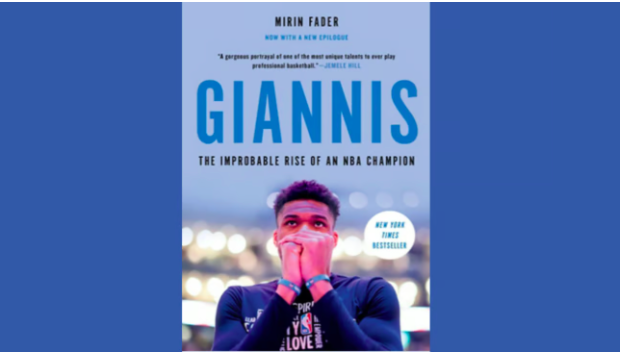
This Books & Biceps interview with Giannis author Mirin Fader appeared in issue 267 of my Books & Biceps newsletter.
The subtitle of this Giannis biography is “the improbable rise of an NBA champion.” “Improbable” is a super overused word, but when it comes to Giannis, and more importantly his personal story and the story of his family, that’s the perfect word. It’s a bullseye. The story of where and how he grew up to where he is today makes no logical sense and could not have been predicted. Ever.
But it can be told. And thankfully, it was told expertly by one of my favorite writers, Mirin Fader, in her biography debut: Giannis.
Mirin and I connected on Twitter a ways back when I was wrapping up a very late night of writing towards the end of ‘1996’ and she was just getting started on Giannis. There’s a special corner of late-night Twitter where writers post random writing thoughts after midnight, on deadline, and we try to encourage each other to keep writing. The book… will… be… done… one…. day.
I asked Mirin if she’d connect for a Books & Biceps Q&A when Giannis was released and she agreed. Of course, nobody knew then what the publishing Gods had in store for her back in 2021…
The Bucks would make the Finals. Giannis would make the leap to icon status and he’d become a Finals MVP… all just a few weeks before the book is slated to come out (August 10th, 2021).
From a writer perspective, it’s the absolute perfect storm of publicity and timing and it’s awesome to see. Even more awesome is this great peak behind-the-scenes of Mirin’s writing process and the book itself. Enjoy!
Please enjoy my Books & Biceps Interview with Giannis author Mirin Fader:
Finkel: In order to have readers truly appreciate how far Giannis has come, you have to anchor the story in his past and describe what his childhood was like. When writing this book, what did you do to get a feel for the Greece of his youth and what were some ways you familiarized yourself with what it was like for him.
Fader: My goal with every story (and now book) is to treat ‘place’ as a character of its own. You want the reader to understand what the place looked like, smelled like, felt like. I was supposed to go to Athens in order to do that reporting, but, with Covid-19, I had to cancel those plans. However, I interviewed 221 people, many of them Greeks who live in Athens, and in Sepolia, the neighborhood Giannis grew up in, to get a real sense of what that place was like. I also hired a researcher on the ground in Sepolia, who would send me videos and take photos of different cities for me. I was interested in everything: the church Giannis and his brothers grew up in (I interviewed the priest), cafes (interviewed owners), basketball courts (interviewed friends), his schools (interviewed teachers). When I set out to write the book, I really wanted to make sure readers felt like they were there. So much of Giannis’ past is unknown: we essentially know only the outline of his life, as in, he grew up very poor, and somehow transcended into a global icon and NBA MVP. This book really aims to be the connective tissue between childhood and adulthood, all of the anecdotes and life experiences that show how his childhood shaped him into the person, man, and player he is today.
Giannis’ story is the modern story of basketball in Milwaukee and to understand that, you’ve said you talked to longtime Bucks fans about what the team means to the city. What part of the Bucks hoops culture did you find the most fascinating?
I loved talking to Bucks fans. What I told them when I set out to interview them was, I want you to feel seen in this book. Bucks fans have gone through *A LOT*. They stuck by this team, and loved this team, through years of awful ownership, losses, and mediocrity. It was so critical to me to understand how Milwaukee basketball came to be. I found fascinating this threat of “leaving.” Ever since the Bucks’ inception, when they left for Atlanta, there was this perception of, ‘Basketball can’t work in Milwaukee.’ Then they get a team again, and Kareem Abdul Jabbar leads them to glory, only to leave. Again, this concept of leaving. So I found it really fascinating to ask Bucks fans what that wound of leaving meant to them, felt like to them. How Kareem leaving was so tied to whether or not Giannis stayed. I could feel the love and elation in Bucks fans when Giannis decided to stay. It was a city that hasn’t had a player want them, choose them, in so long, and it meant the world to include those perspectives in my book. The common thing I’d hear from Bucks fans was: “We love Giannis because we feel like we watched him grow up. We grew up with him.” You don’t see that too much in the modern NBA.
While you were writing/researching this book, what is the one story/person/event you uncovered about Giannis that made you do a double take – like, OH MY GOSH, I can’t believe that actually happened!
Learning about his rookie year and how incredibly lonely Giannis was shocked me. I think during his rookie year, he was framed as such a feel-good story, because he was discovering smoothies and American slang and it looked like, from the outside, he was having a ball. He was always pictured smiling, laughing. America fell in love with him and found him endearing and adorable and easy to root for. But when Alex, Giannis’ youngest brother, told me that Giannis was so lonely, and so sad, and so lost, that he nearly quit the NBA, by telling him: If you (and the rest of the family) can’t come over here to America I’m going back to Greece.” I had no idea he was suffering that much inside. Certainly those outside the organization didn’t know either. I mean, what if his family couldn’t get the VISA’s to come to America? Would Giannis truly have gone back to Greece, and the Greek Freak would have never taken off? Fascinating to think about.
BONUS QUESTION
Who was the most interesting person you interviewed for the book that most people have never heard of before and why?
The most interesting person I interviewed that most haven’t heard of is Rahman Rana. He was a close friend of Giannis’ growing up in Sepolia, as he, too, played for Filathlitikos for a period of time. Rana, who is of Pakistani descent, described to me the racism that Giannis (and Rana himself) faced, as boys of color in often white spaces. This part of Giannis’ story is often swept under the rug, but Rana described moments where Giannis and his brothers were faced with this kind of discrimination. Through Rana, I was able to find other childhood friends who were also boys of color, who did not grow up and have the kind of privilege and success Giannis was able to, because unlike Giannis, they were never granted citizenship papers or passports or opportunities to ascend. I included those stories in order for readers to understand just how improbable Giannis’ rise was. Had he not gotten citizenship, he likely would have a similar trajectory to other boys of color in Athens.
If you enjoyed this interview, sign up for my FREE weekly Books & Biceps newsletter.
Join the home of the sophisticated meathead community, where I share books, workouts and columns to help dudes and dads read more, lift more & live awesome.

And if you’re interested in other hoops books, how about a few I wrote: